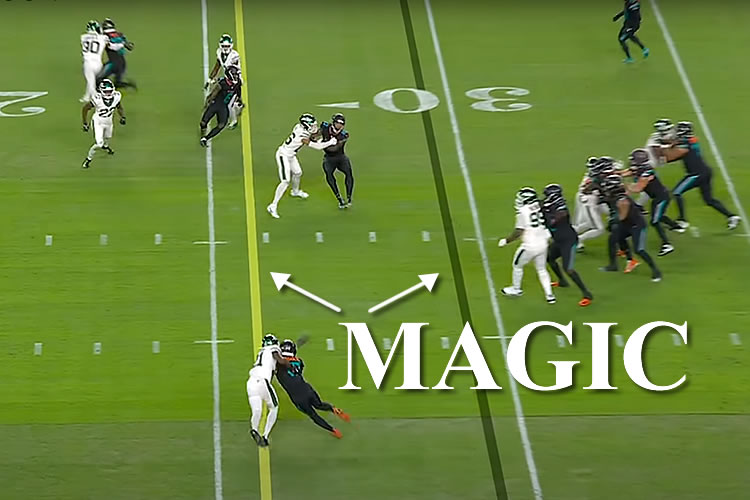You’re watching football. The quarterback lines up, the linemen slam into each other, and there it is: a yellow stripe stretching across the gridiron, telling you exactly how far the offense needs to go. To the naked eye it looks like it’s painted on the field, part of the yard markers. But it isn’t. No player trips over it. Referees don’t measure it. It exists only for you, the viewer at home.
That yellow line, as simple as it looks, is one of the greatest visual tricks in broadcast history. It was first introduced on September 27, 1998, during an ESPN telecast of a Bengals–Ravens game. The technology behind it was groundbreaking—on par with special effects in Jurassic Park—because unlike movie CGI, which could be rendered ahead of time, this had to happen in real time, during a live broadcast with moving cameras and unpredictable plays.
How the Yellow Line Works
The system was invented by Sportvision, a California-based graphics company. The principle sounds straightforward: overlay a digital line on the field, lock it in place, and make sure it never covers up players or the ball. The execution, though, required some real engineering wizardry.
Each broadcast camera used for football coverage was equipped with sensors that reported the exact tilt, zoom, and pan of the lens. At the same time, technicians built a digital 3D model of the football field, complete with yard markers, sidelines, and perspective. As the camera moved, the software recalculated where the line should appear, always matching the geometry of the real turf.
That solved one part of the puzzle: making the line look like it was actually on the grass. But how do you keep it from bleeding over players’ uniforms or referees’ jerseys? The answer was something like green-screen technology, but in reverse. Instead of removing a color background, the system identified the exact shades of green in the field itself. The computer only drew the line where “field green” appeared in the video feed. Jerseys, helmets, and skin tones were excluded. The effect was seamless: players ran over the line, but the line never ran over them.
When it debuted, the hardware required to pull this off filled racks of computers. The amount of processing power needed to analyze live video, track the cameras, and composite the digital line in real time was enormous. Today, the same trick can be run on a modern graphics card, but in the late 1990s it was a moonshot.
Beyond the Gridiron
Once the football yellow line became a hit, the same idea spread to other sports. Baseball broadcasts introduced the strike zone box, allowing fans to see exactly where a pitch crossed the plate. Tennis and soccer adopted “virtual lines” to illustrate close calls and offsides. Golf got digital ball-flight arcs tracing impossible-to-follow drives against the sky.
Some of the earliest experiments came even before the yellow line. In 1996, Fox tried puck tracking in hockey, surrounding the puck with a digital glow and even adding a trailing comet tail for slap shots. Fans had mixed feelings—some loved it, traditionalists hated it—but it was the same principle: computer vision layered onto live sports.
By the mid-2000s, technologies like “Hawkeye” in tennis and cricket were using similar methods to replay ball trajectories in 3D, even influencing officiating decisions. What started as a broadcast convenience for viewers was becoming part of the game itself.
🍁 Make a One-Time Contribution — Stand Up for Accountability in Vermont 🍁
From Graphics to Augmented Reality
Today, the yellow line feels ordinary—so ordinary that viewers might forget it isn’t really there. But the principle behind it has blossomed into full-fledged augmented reality for sports broadcasts.
During NFL games, you might see a 3D rendering of a giant player “standing” on the field during introductions. During halftime, sponsor logos appear painted across the turf, visible only to TV audiences. In baseball, strike zone boxes have evolved into full AR displays showing pitch sequences and probabilities. Basketball broadcasts now overlay shot charts, player names, and even real-time tracking of speed and distance.
None of this would have been possible without that first yellow line. The core ideas—camera calibration, field modeling, color keying, and real-time rendering—remain the backbone of sports AR graphics today.
Why It Matters
Sports graphics aren’t just eye candy. They change how we experience the game. The yellow line gave casual viewers an instant sense of down and distance, no longer requiring expert eyes to parse the action. The baseball strike zone has fueled endless debates about umpire accuracy. Tennis line graphics add confidence to close calls.
And it’s a reminder that some of the most powerful technology isn’t about dazzling spectacle—it’s about disappearing into the background so seamlessly that you forget it’s there. You don’t “notice” the yellow line anymore. You just expect it.
Twenty-seven years after its debut, the yellow line stands as one of sports broadcasting’s quiet revolutions. It wasn’t just a gimmick. It was the doorway to an era where the boundaries between reality and graphics blurred, all in the service of making the game easier—and more fun—to watch.
Dave Soulia | FYIVT
You can find FYIVT on YouTube | X(Twitter) | Facebook | Instagram
#fyivt #SportsTechnology #FootballHistory #AugmentedReality
Support Us for as Little as $5 – Get In The Fight!!
Make a Big Impact with $25/month—Become a Premium Supporter!
Join the Top Tier of Supporters with $50/month—Become a SUPER Supporter!









Leave a Reply